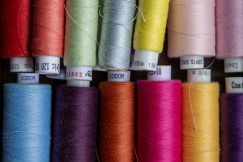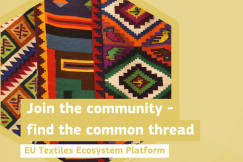Library and support resources
08 October 2025
Unlocking the circular economy potential in Japan’s textile and fashion industries
Library and support resources
08 October 2025
R&I, techniques and technological solutions
Skills
Social dimension
+7 more
Login / create an account to be able to react
-
28

In ‘Unlocking the Circular Economy Potential in the Textiles and Fashion Industries of Japan: Opportunities for European Businesses,’ Manuel Herrador and Mayu Imanishi explore Japan’s evolving circular textile sector and its potential for EU collaboration. The paper presents Japan as a culturally grounded yet innovation-driven partner in advancing sustainable textile ecosystems worldwide.
Topics
Albania
Armenia
Austria
Belgium
Bosnia and Herzegovina
Bulgaria
Croatia
Cyprus
Czechia
Denmark
Estonia
EU-27
Finland
France
Georgia
Germany
Greece
Hungary
Iceland
Ireland
Italy
Kosovo
Latvia
Liechtenstein
Lithuania
Luxembourg
Malta
Moldova
Montenegro
Netherlands
North Macedonia
Norway
Poland
Portugal
Romania
Serbia
Slovakia
Slovenia
Spain
Sweden
Switzerland
Türkiye
Ukraine
Other
Academic / Research and VET Institutions
Business Support Organisation
Company with 250 or more employees
Cluster Organisations
Financial Institutions and Investors
Industry Associations and Chambers of Commerce
International Organisations
National authorities
Networks and Federations / Confederations
NGOs / Non-profits
SMEs (a company with less than 250 employees)
Social Economy Entity
-
Transition Pathway's building blocks
-
-
R&I, techniques and technological solutions
-
Skills
-
Social dimension
-
Sustainable competitiveness
-
Regulation and public governance
-
-
Industrial ecosystems
-
-
Textile
-
-
Textiles ecosystem areas
-
-
Fibres, yarns and fabrics
-
Apparel and clothing accessories
-
Research and Innovation
-
Waste management, reuse and repair
-
Share
The research paper ‘Unlocking the Circular Economy Potential in the Textiles and Fashion Industries of Japan: Opportunities for European Businesses’ by Manuel Herrador and Mayu Imanishi, published in the Journal of Cleaner Production, examines Japan’s distinctive approach to the circular economy (CE) in the circular textiles and fashion (CTF) sector. It highlights how Japan’s traditional ‘mottainai’ culture centred on minimising waste has evolved into a modern system of circular practices supported by technology, recycling, and reuse.
The paper explores Japan’s textile industry against the backdrop of major demographic and economic changes, with domestic sales declining from 15 trillion yen in 1991 to 8 trillion yen in 2020 and consumption patterns increasingly shifting towards imported mass production. In response, Japan has leveraged both its cultural heritage and innovation capacity to advance circularity through initiatives like second-hand retail networks, repair culture, and advanced chemical recycling. The paper also underscores the need for deeper collaboration with the EU to enhance sustainable textile practices through shared frameworks and policies.
Key Takeaways
- The paper develops a collaborative EU-Japan framework to strengthen circular textile and fashion systems through shared innovation and policy alignment.
- Japan’s circular textile practices build upon the traditional ‘mottainai’ philosophy while integrating digital resale platforms and advanced recycling facilities.
- Toray has pioneered recycling technologies capable of separating feathers and textiles, while Uniqlo’s large-scale collection initiative recycled one million garments by 2022.
- The EU Strategy for Sustainable and Circular Textiles and the Eco-design for Sustainable Products Regulation serve as complementary frameworks for EU-Japan cooperation, encouraging durability, repairability, and fibre recycling.
- The study identifies barriers to collaboration, including differing consumer behaviour, regulatory frameworks, and the high costs of circular technology adoption.
- Japan’s artisanal expertise and innovation culture position it as a catalyst in advancing global textile circularity and sustainable industry transformation.
The writers conclude that Japan’s blend of traditional craftsmanship, technological innovation, and sustainability commitment provides a strong foundation for future EU-Japan cooperation. By aligning policy, innovation, and circular business models, the two regions can accelerate the global shift towards sustainable textiles.
To read the full paper, visit the Journal of Cleaner Production page for 'Unlocking the Circular Economy Potential in the Textiles and Fashion Industries of Japan: Opportunities for European Businesses' by Manuel Herrador and Mayu Imanishi.
Comments (0)
See also
The EIT KICs Position Paper for a Circular and Sustainable Fashion and Textiles Industry in Europe
- Categories
- Infrastructure Investments and funding R&I, techniques and technological solutions +20 more
Get the most out of the EU Textiles Ecosystem Platform: the Beginner kit is now available
- Categories
- Infrastructure Investments and funding R&I, techniques and technological solutions +28 more
The EU Textiles Ecosystem Platform publishes the first Report on Best Practices
- Categories
- Infrastructure Investments and funding R&I, techniques and technological solutions +19 more



